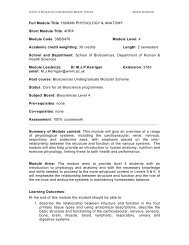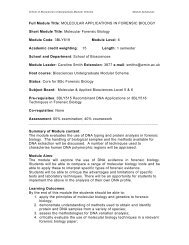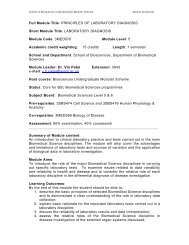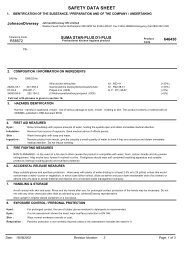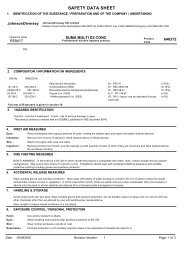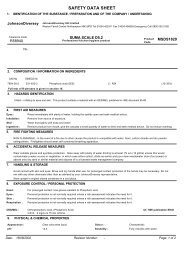CONTENTS 1. Introduction 1.1 Course Outline 1 1.2 Introduction ...
CONTENTS 1. Introduction 1.1 Course Outline 1 1.2 Introduction ...
CONTENTS 1. Introduction 1.1 Course Outline 1 1.2 Introduction ...
You also want an ePaper? Increase the reach of your titles
YUMPU automatically turns print PDFs into web optimized ePapers that Google loves.
Full Module Title:<br />
DIGITAL IMAGE MANAGEMENT<br />
Short Module Title: DIGITAL IMAGE MANAGEMENT<br />
Module Code: 2DPI410 Module Level: 4<br />
Academic credit weighting: 15 Credits<br />
Length: 1 semester<br />
School:<br />
Media, Arts and Design<br />
Department:<br />
Photographic and Digital Media<br />
Module Leader: Liz Allen Extension: 4083<br />
Host <strong>Course</strong>:<br />
BSc(Hons) Photography and Digital Imaging<br />
Status:<br />
Core<br />
Pre-requisites:<br />
None<br />
Co-requisites:<br />
None<br />
Assessment:<br />
80% Practical Projects<br />
20% Written <strong>Course</strong>work.<br />
Summary of Module content: Digital Imaging, Colour management, Image management<br />
This module is a practical module, comprising a series of tutorials, workshops and projects, to equip<br />
students with the technical skills and understanding to manage digital images at all stages of the<br />
imaging chain. At the end of the module students will have an understanding of the optimisation and<br />
colour management of digital devices. They will also have the software skills to enhance and<br />
manipulate digital images to fulfil the requirements of a creative brief.<br />
Module Aims:<br />
• To give students an understanding of the nature of digital images.<br />
• To educate students in the management of digital images at all stages of the imaging chain.<br />
• To introduce a variety of imaging systems and devices and to teach the skills required to use and<br />
understand them.<br />
• To equip students with the tools to optimise colour reproduction in a digital imaging chain.<br />
• To provide an awareness of problems in imaging systems and methods of selecting the best<br />
system for the job.<br />
• To equip students with the technical skills to enhance and manipulate digital images.<br />
Learning Outcomes:<br />
On completion of the module, the successful student will be able to:<br />
<strong>1.</strong> Acquire and process images using a wide variety of contemporary imaging systems.<br />
2. Determine the optimum imaging systems to use for a specific application.<br />
3. Understand the consequences of the relative performances of different systems and devices.<br />
4. Understand the principles of colour management in the digital imaging chain and be able to<br />
use profiling and calibration tools to optimise colour reproduction.<br />
5. Demonstrate relevant practical skills in the use of equipment and software for the production<br />
and enhancement of digital images.<br />
6. Employ materials, media, techniques, methods, technologies and tools associated with the<br />
discipline with skill and imagination whilst observing good working practices.<br />
Indicative syllabus content:<br />
• Digital image representation. Resolution, file size and bit depth.<br />
• The digital imaging chain and calibration of devices.<br />
• Colour management methods & using profiles.<br />
• Image acquisition.<br />
• Image correction & enhancement.<br />
• Image restoration.<br />
• Image manipulation.<br />
• Image output.<br />
• File storage and migration.<br />
DPI_Hbook 47 ©University of Westminster





